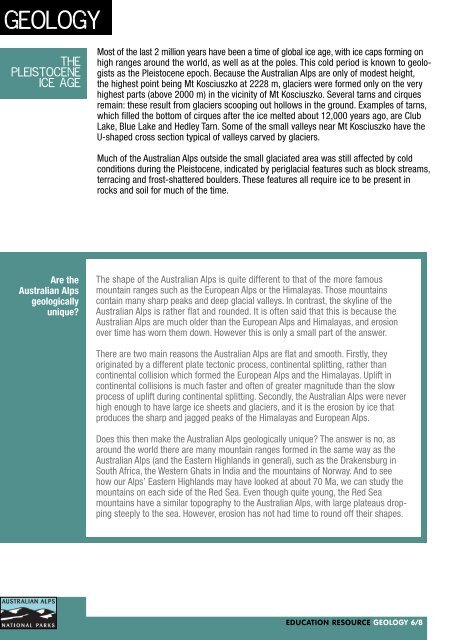Geology of the Australian Alps - Australian Alps National Parks
Geology of the Australian Alps - Australian Alps National Parks
Geology of the Australian Alps - Australian Alps National Parks
You also want an ePaper? Increase the reach of your titles
YUMPU automatically turns print PDFs into web optimized ePapers that Google loves.
geology<br />
The<br />
pleistocene<br />
ice age<br />
Most <strong>of</strong> <strong>the</strong> last 2 million years have been a time <strong>of</strong> global ice age, with ice caps forming on<br />
high ranges around <strong>the</strong> world, as well as at <strong>the</strong> poles. This cold period is known to geologists<br />
as <strong>the</strong> Pleistocene epoch. Because <strong>the</strong> <strong>Australian</strong> <strong>Alps</strong> are only <strong>of</strong> modest height,<br />
<strong>the</strong> highest point being Mt Kosciuszko at 2228 m, glaciers were formed only on <strong>the</strong> very<br />
highest parts (above 2000 m) in <strong>the</strong> vicinity <strong>of</strong> Mt Kosciuszko. Several tarns and cirques<br />
remain: <strong>the</strong>se result from glaciers scooping out hollows in <strong>the</strong> ground. Examples <strong>of</strong> tarns,<br />
which filled <strong>the</strong> bottom <strong>of</strong> cirques after <strong>the</strong> ice melted about 12,000 years ago, are Club<br />
Lake, Blue Lake and Hedley Tarn. Some <strong>of</strong> <strong>the</strong> small valleys near Mt Kosciuszko have <strong>the</strong><br />
U-shaped cross section typical <strong>of</strong> valleys carved by glaciers.<br />
Much <strong>of</strong> <strong>the</strong> <strong>Australian</strong> <strong>Alps</strong> outside <strong>the</strong> small glaciated area was still affected by cold<br />
conditions during <strong>the</strong> Pleistocene, indicated by periglacial features such as block streams,<br />
terracing and frost-shattered boulders. These features all require ice to be present in<br />
rocks and soil for much <strong>of</strong> <strong>the</strong> time.<br />
Are <strong>the</strong><br />
<strong>Australian</strong> <strong>Alps</strong><br />
geologically<br />
unique?<br />
The shape <strong>of</strong> <strong>the</strong> <strong>Australian</strong> <strong>Alps</strong> is quite different to that <strong>of</strong> <strong>the</strong> more famous<br />
mountain ranges such as <strong>the</strong> European <strong>Alps</strong> or <strong>the</strong> Himalayas. Those mountains<br />
contain many sharp peaks and deep glacial valleys. In contrast, <strong>the</strong> skyline <strong>of</strong> <strong>the</strong><br />
<strong>Australian</strong> <strong>Alps</strong> is ra<strong>the</strong>r flat and rounded. It is <strong>of</strong>ten said that this is because <strong>the</strong><br />
<strong>Australian</strong> <strong>Alps</strong> are much older than <strong>the</strong> European <strong>Alps</strong> and Himalayas, and erosion<br />
over time has worn <strong>the</strong>m down. However this is only a small part <strong>of</strong> <strong>the</strong> answer.<br />
There are two main reasons <strong>the</strong> <strong>Australian</strong> <strong>Alps</strong> are flat and smooth. Firstly, <strong>the</strong>y<br />
originated by a different plate tectonic process, continental splitting, ra<strong>the</strong>r than<br />
continental collision which formed <strong>the</strong> European <strong>Alps</strong> and <strong>the</strong> Himalayas. Uplift in<br />
continental collisions is much faster and <strong>of</strong>ten <strong>of</strong> greater magnitude than <strong>the</strong> slow<br />
process <strong>of</strong> uplift during continental splitting. Secondly, <strong>the</strong> <strong>Australian</strong> <strong>Alps</strong> were never<br />
high enough to have large ice sheets and glaciers, and it is <strong>the</strong> erosion by ice that<br />
produces <strong>the</strong> sharp and jagged peaks <strong>of</strong> <strong>the</strong> Himalayas and European <strong>Alps</strong>.<br />
Does this <strong>the</strong>n make <strong>the</strong> <strong>Australian</strong> <strong>Alps</strong> geologically unique? The answer is no, as<br />
around <strong>the</strong> world <strong>the</strong>re are many mountain ranges formed in <strong>the</strong> same way as <strong>the</strong><br />
<strong>Australian</strong> <strong>Alps</strong> (and <strong>the</strong> Eastern Highlands in general), such as <strong>the</strong> Drakensburg in<br />
South Africa, <strong>the</strong> Western Ghats in India and <strong>the</strong> mountains <strong>of</strong> Norway. And to see<br />
how our <strong>Alps</strong>’ Eastern Highlands may have looked at about 70 Ma, we can study <strong>the</strong><br />
mountains on each side <strong>of</strong> <strong>the</strong> Red Sea. Even though quite young, <strong>the</strong> Red Sea<br />
mountains have a similar topography to <strong>the</strong> <strong>Australian</strong> <strong>Alps</strong>, with large plateaus dropping<br />
steeply to <strong>the</strong> sea. However, erosion has not had time to round <strong>of</strong>f <strong>the</strong>ir shapes.<br />
EDUCATION RESOURCE GEOLOGY 6/8

















